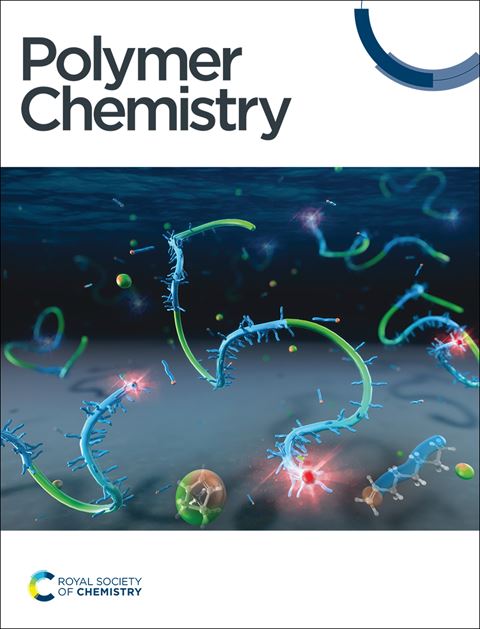用丙烯酸酯大单体代替MacroRAFT试剂进行聚合诱导微相分离的3D打印
IF 4.1
2区 化学
Q2 POLYMER SCIENCE
引用次数: 0
摘要
聚合诱导微相分离(PIMS)是制造纳米结构材料的一种通用技术。将PIMS与3D打印相结合,可以制造具有纳米级特征的复杂物体,为各种应用开辟了可能性,包括纳米结构陶瓷、固体聚合物电解质和离子交换材料。传统上,PIMS使用可逆加成-破碎链转移(RAFT)聚合合成的聚合物(macromolecular chain transfer Agents, macrocta)。然而,基于raft的PIMS会在最终材料中引入不良的颜色和气味。为了解决这些限制,本研究探讨了使用高分子单体,以丙烯酸酯或甲基丙烯酸酯基团终止的聚合物,作为macrocta的替代品。我们合成了一系列分子量相同但末端功能不同的聚己内酯(PCL)变体:丙烯酸酯、甲基丙烯酸酯、三硫代碳酸盐和二硫代苯甲酸酯。该库可以直接比较通过PIMS制造纳米结构材料的宏单体和宏cta方法。采用小角x射线散射(SAXS)测定纳米畴尺寸。值得注意的是,丙烯酸酯和三硫代碳酸盐端接的pcl产生了相当的纳米结构域尺寸。利用PCL的降解,我们利用三硫碳酸盐和丙烯酸酯末端PCL形成的材料选择性蚀刻PCL,制造出纳米多孔的3d打印物体。关键的是,丙烯酸酯端端宏观单体的PIMS系统产生透明,无色的材料具有明确的微观结构。这项工作证明了大分子单体克服RAFT-PIMS固有局限性的潜力,为先进的纳米结构材料提供了更清洁、更通用的途径。本文章由计算机程序翻译,如有差异,请以英文原文为准。
3D Printing via Polymerization-Induced Microphase Separation using Acrylate Macromonomers instead of MacroRAFT Agents
Polymerization-induced microphase separation (PIMS) is a versatile technique for manufacturing nanostructured materials. Combining PIMS with 3D printing enables the fabrication of complex objects with nanoscale features, opening possibilities in diverse applications, including nanostructured ceramics, solid polymer electrolytes, and ion-exchange materials. Traditionally, PIMS utilizes polymers synthesized by reversible addition-fragmentation chain transfer (RAFT) polymerization (macromolecular Chain Transfer Agents, macroCTAs). However, RAFT-based PIMS can introduce undesirable color and odor into the final materials. To address these limitations, this study explores the use of macromonomers, polymers terminated with acrylate or methacrylate groups, as alternatives to macroCTAs. We synthesized a series of polycaprolactone (PCL) variants with identical molecular weights but differing terminal functionalities: acrylate, methacrylate, trithiocarbonate, and dithiobenzoate. This library enabled a direct comparison of macromonomer and macroCTA approaches for nanostructured material fabrication via PIMS. Small-angle X-ray scattering (SAXS) was employed to determine nanodomain sizes. Notably, both acrylate and trithiocarbonate-terminated PCLs yielded comparable nanodomain sizes. Exploiting PCL degradation, we fabricated nanoporous, 3D-printed objects by selectively etching the PCL from materials formed with both trithiocarbonate and acrylate-terminated PCL. Critically, the acrylate-terminated macromonomer-based PIMS system produced transparent, colorless materials with well-defined microstructures. This work demonstrates the potential of macromonomers to overcome the inherent limitations of RAFT-PIMS, providing a cleaner and more versatile pathway to advanced nanostructured materials.
求助全文
通过发布文献求助,成功后即可免费获取论文全文。
去求助
来源期刊

Polymer Chemistry
POLYMER SCIENCE-
CiteScore
8.60
自引率
8.70%
发文量
535
审稿时长
1.7 months
期刊介绍:
Polymer Chemistry welcomes submissions in all areas of polymer science that have a strong focus on macromolecular chemistry. Manuscripts may cover a broad range of fields, yet no direct application focus is required.
 求助内容:
求助内容: 应助结果提醒方式:
应助结果提醒方式:


